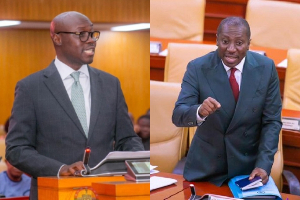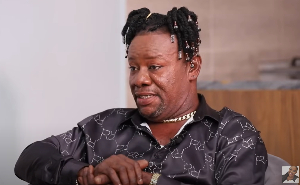By Asante customary law and usage, the Asantehene does not play any role in the nomination, election, and installation of a paramount chief. A newly installed paramount chief is introduced to the Asantehene only as a formality. It is for this reason that one finds it utterly perplexing that His Majesty, the Asantehene, could make such a profound statement - that he is the kingmaker of every stool in Asanteman. The statement has no basis in both statutory and customary law:
"I am the kingmaker of every stool in Asanteman _ Otumfuo Osei-Tutu I|":
Let's face it. Some news headlines can be pretty irritating. As if certain journalists are in the running to win the 'Fastest Fingers' award, they rush to press the moment they hear of a story.
They string together the most bizarre and sensational of headlines to grab readers' fleeting attention.
With the above thoughts inhabiting my mind, I was tempted not to dignify the reporter of the above-quoted headline with my one or two minutes to read whatever disjointed story accompanied such sacrilege of a headline.
Against my better judgment, I decided to read the story. To my utter shock, the headline did proclaim the story. As it was, Otumfuo Osei Tutu Il, His Majesty the Asantehene, had reportedly stated that he was the kingmaker of every stool in Asanteman. His Majesty was reported to have made the statement when presiding over a meeting at which matters regarding the enstoolment of a new paramount chief of Off Traditional Area were discussed.
Is it true that Asantehene is the kingmaker of every stool in Asanteman? This article discusses Asante's customary law and procedure for enstooling a chief. It also points out some cases in which the Supreme Court has affirmed Asante customary law on the enstoolment of a paramount chief or queen-mother. The writer contends that in the light of Asante customary law and decided cases of the Supreme Court, Otumfuo Osei-Tutu and any other Asantehene for that matter - is not a kingmaker of every stool in Asanteman.
Therefore, the Asantehene's purported role in the nomination, election, or selection and enstoolment of the paramount chief of Offinso Traditional Area sins against the age-old customs, usages, and traditions of Asanteman.
Akan/Asante custom and procedure for enstoolment of a chief:
Customary law is recognized as part of the laws of Ghana. "Customary law" means the rules of law, which by custom apply to particular communities in Ghana.[2] The Constitution defines a "chief' as "a person, who, hailing from the appropriate family and lineage, has been validly nominated, elected or selected and enstooled, enskinned or installed as a chief or queenmother in accordance with the relevant customary law and usage."[3]
In his book,[4] renowned Asante historian, Osei Kwadwo, sets out the procedure for the nomination, selection, and enstoolment/installation of a chief among Asantes. He states that when a stool becomes vacant, a new chief is nominated to occupy it. A stool becomes vacant when the occupant dies or is destooled or abdicates. The processes that must be followed before a new chief is enstooled are as follows:
Interested royals send their applications to occupy the stool through some chiefs to the queen mother. The term used is
"apology to occupy the stool." The interested person will usually present drinks (Schnapps) with an "apology."
When the apologies are received from the royals, the queen mother, and the family elders sit on camera to vet the applicants.
Here, the applicants are not called for an interview but the queen mother and the elders discuss each of them, That is, their past and present records, general comportment, and their suitability. They may reach a consensus on three of the applicants - the most favored, the second favored, and the third favored candidate.
It must be noted that the queen mother is limited to making three choices.
The next stage is for the queen mother to present the most favored applicant's name to the kingmakers. If the kingmakers accept the first nominee, he goes through further processes leading to his installation.
According to Osei Kwadwo, in most cases, the first nominee is accepted. What happens is that the queen mother and her elders try to find the royal with an unquestionable character, who possesses the personality that befits the status of a chief before she sends the name to the kingmakers. Apart from these qualities, the queen mother and her elders try to nominate a popular candidate. However, if all her three nominees are rejected, the queen mother, being the mother of all the royals, is expected to ask the kingmakers to choose one of the royals they would like to have enstooled as the chief.
Osei Kwadwo continues that in the olden days, the queen mother was obliged to accept the royal the kingmakers chose. It was also expected that the kingmakers would give tangible reasons for rejecting any of the queen mother's nominees. In those days when the above procedures were not followed and consensus was not reached, the stalemate often resulted in civil wars. In recent years, such stalemates have led to protracted litigation.
The Supreme Court's affirmation of Asante custom for enstooling a chief or queen mother
As the Supreme Court noted in the case of In re Wenchi Stool Affairs; Sramangyedua v Nketia, [5] article 277 of the Constitution, 1992 states the prerequisites that must be satisfied when considering the installation of a chief. The prerequisites are nomination, election/selection, and enstoolment/enskinment/installation. These requirements must be satisfied according to the peculiar customs and usages of the people in the area for whom the chief is being considered.
In areas where nomination is an essential requirement before settling on a person to be considered as a chief, nomination is the most fundamental requirement. Nomination in this context simply means the proposal of a person for election or selection as a chief. Essentially, nomination boils down to naming or declaring a person who is considered by the queen mother as the rightful person to be made a chief.
The Supreme Court noted further that, the nomination should first take place before all the other processes can follow. In other words, it should always precede the election, selection, enstoolment, and installation of the chief. These processes depend on the existence of an appropriate candidate. They can only be performed after nomination. If no person is nominated, there will be no person to be elected, selected, enstooled, or installed as a chief. In effect, nomination is sine qua non to the making of a chief, under normal circumstances.
As Mr. Justice S. A. Brobbey noted in his opinion in In re Wenchi Stool Affairs; Sramangyedua v Nketia,[6] at customary law, there are well-settled procedures to follow in making the nomination. It is not everybody or anybody who can make a nomination. By custom, only accredited queenmothers are authorized to make nominations. The only exception to the rule on nomination by queen mothers is when the kingmakers take over the making of a chief after the queen mother fails or refuses to make the nomination.
Thus, the Supreme Court held that the 1St respondent was the queen mother of Wenchi. In that capacity, she was the rightful person to nominate a candidate for consideration as the chief of Wenchi (Wenchihene). Since the kingmakers purportedly got one Obaapanin Frema Atuahene - who was not the queen mother
- to nominate Kwadwo Nketia (1St appellant) and he was later installed as chief of Wenchi, Kwadwo Nketia's nomination, selection, and installation as Wenchihene was void.
The Supreme Court further held that the 24 hour-period within which the kingmakers pressed the queen mother (1st respondent) to nominate a candidate was unreasonable. The queen mother had requested 3 weeks to nominate a suitable candidate as she needed to make the necessary consultations|71 before deciding on her choice of a nominee. In the circumstances, the kingmakers could not set unreasonable timelines for the queen mother and turn around to use that as an excuse to bypass the queen mother and nominate and install a chief on their own.
Asantehene is not a kingmaker of paramount stools in Asanteman:
As the Supreme Court rightly notes in Republic v Osei Bonsu II, Mamponghene; Ex parte Amadie & Buor,[8] the installation of a chief is the preserve of the queen mother and kingmakers of the stool.
The installation of a queen mother is the preserve/domain of the kingmakers of the particular stool. It is when the chief or queen mother is validly nominated, elected, and installed that he/she is introduced to the townsfolk. The chief or queen mother is later introduced to the Asantehene or Asantehemaa (as the case may be) after all the constitutional /customary processes have been concluded. The introduction to Asantehene/Asantehemaa is, therefore, merely a formality and not part of the essential requirements of enstoolment of a chief or queenmother in Asanteman.
Thus, by Asante custom and tradition, the Asantehene has no role whatsoever to play in the processes of nominating, selecting, or electing, and installing a paramount chief in Asanteman.
That explains why in Brobbey & Others v Kwaku & Others, [9] for instance, when Major (Rtd) Osei Kwaku (aka Kwaku Krakye) petitioned the then Asantehene - Otumfuo Opoku Ware Il - regarding the nomination of one F. K Cartey as Mamponghene, the Asantehene did not favour him with a response.
The Asantehene, Otumfuo Opoku Ware II, resisted that invitation to intervene in the Mamponghene's nomination, selection/election, and installation as His Majesty knew he had no jurisdiction whatsoever to meddle in such matters that were, by customary and constitutional law, entrusted exclusively to the queen mother and kingmakers of the Mampong Silver Stool. Indeed, it is because of that reason that the respondents in chieftaincy petition cases are usually the queenmother and kingmakers - mostly the Krontihene and Akwamuhene, and other Divisional chiefs (nananom atenankonwa) - who may have played a role as kingmakers in the enstoolment processes of the particular stool. [10]
In the light of the essential prerequisites for the enstoolment of a chief under customary law as espoused by Asante history (Rattray & Osei Kwadwo) and in the decided cases of the Supreme Court (In re Wenchi Stool Affairs;
Sramangyedua v Nketia, Republic v Osei Bonsu Il, Mamponghene; Ex parte Amadie & Buor and Brobbey & Others v Kwaku & Others), the Asantehene cannot by any stretch of Asante customary law, tradition or usage, be said to be the kingmaker of every paramount stool in Asanteman.
E: The illegality of the purported role of Asantehene in the choice and enstoolment of the paramount chief of Offinso
The power entrusted to queen mothers in Akan (and specifically, Asante) custom to nominate chiefs is not one to be taken lightly. It is the very expression of the primacy of the matrilineal heritage of Akans. It embodies the significance and relevance of the female members of Akan royalty and tradition.
In recent times, the news portals have been heavy with news about the nomination of one Dr. K. K. Sarpong by the queen mother of Offinso - Nana Ama Serwaa Nyarko - to be selected and installed as the paramount chief of Offinso Traditional Area. As has been demonstrated in this article, by Asante customary law, the queen mother of Offinso is the rightful person to nominate a candidate to ascend the vacant Offinso stool.
There have not been any reports that the kingmakers of the Offinso stool have rejected the queen mother's said nominee for Offinsohene.
Indeed, by customary law, even if a queen mother's first nominee is rejected, the queen mother has two more chances to nominate a candidate.
It, therefore, came as a surprise to many observers in Asanteman when it was published in the news that the Asantehene had 'rejected" the queen mother's nominee for Offinso paramount chief.[11] The question on many an observer's mind was this: By what Asante custom or usage is Asantehene vetoing the lawful customary decision of the queen mother, Offinsohemaa?
Matters reached a crescendo when the Asantehene openly declared his objection to the queen mother's nominee at Manhyia Palace.
Needless to say, both the queen mother and the nominee were not present when the Asantehene made the said declaration. When news broke about the action taken by the Asantehene at Manhyia Palace to veto and disregard the queen mother's nomination of their paramount chief, the youth of Offinso organized a demonstration in Offinso. The youth did so to register their protest against what they perceived as the Asantehene's disrespect towards their queen mother and his unlawful interference in the customary processes leading to the installation of a new Offinsohene.
As if the declaration of rejection of the queen mother's nominee was not subversive of customary law enough, recent news reports indicate that the Asantehene has subsequently summoned the kingmakers and candidates vying for Offinsohene to Manhyia Palace. Again, both the queen mother and the queen mother's nominee were absent. In fact, dozens of men were seen jostling to introduce themselves to Asantehene as Offinso royals and potential candidates for Offinsohene.[12] It was a sore spectacle, indeed
One cannot hazard a guess as to the source of the customary law that clothes the Asantehene with lawful authority to hold court at Manhyia Palace and purport to make a choice of a suitable candidate to become Offinsohene, or any other paramount chief in Asanteman for that matter.
Perhaps, recognizing that he had no power to choose a potential Offinsohene from the lot that presented themselves, Asantehene tasked the Offinso kingmakers he had summoned before him to go and choose a candidate and present him to Manhyia Palace at a later date. With all due respect, that assignment is brutum fulmen ab initio[13] - it has no legal basis and it will have no legal effect. The simple reason is that the kingmakers cannot undertake any such exercise without going through the requisite customary processes involving the queen mother, Offinsohemaa.
It is unclear how anyone could imagine that an Offinsohene could be nominated, selected, and installed without Offinsohemaa's participation in the customary processes. As the saying goes, coming events cast their shadow. If the demonstrating Offinso youth were bold enough to organize a press conference to state their objection to Asantehene's perceived interference in Offinso stool affairs, one can well imagine the fate that awaits whoever will emerge as Offinsohene through any unlawful customary processes.
It is submitted that the declaration so made by the Asantehene - that he is the kingmaker of every stool in Asanteman - is contrary to all notions of customary law and practice among the Asante. It is null and void and thus, has no legal effect on whatever processes Offinsohemaa and the kingmakers will undertake by custom to install a new Offinsohene - whether in the person of the current nominee or otherwise.
In any event, if it turns out that the nominee, or any other person who may be nominated by the queen mother and installed, is not royal of the Offinso Asona stool, there are legal processes by which the person will be brought down from his perch in his palanquin. Those legal processes were followed in cases such as Brobbey & Others v Kwaku & Others[14] (Mampong Stool affairs) and Yeboa-Kodie Asare I| (Yonsohene & Benkumhene of Jamasi) & Another (No. 1) v Addai (Yonso Bedomasi-Bretuo Abusuapanin & Others (No. 1)[15] (Yonso Stool affairs). But until the proper customary and statutory legal processes are exhausted, any attempt by any person to side-step the age-old customs and traditions of Asante on enstoolment of a chief will only serve as a recipe for civil disorder, protracted litigation, and under-development.
On Saturday, 3 August 1991, I was old enough when I witnessed a section of the youth in Mampong set Mr. F. K Cartey's Hyundai car on fire in broad daylight at Mampong Silver Stool Palace. The youth did so to protest Mr. Cartey's installation as Mamponghene. He had then been installed, under the stool name Nana Akuamoah Boateng Ababio, and he was visiting Mampong to celebrate Akwasidae the next day.
Nana Akuamoah Boateng Ababio himself managed to escape by a hair's breadth. His car was burnt to ashes. What followed was a protracted litigation that dragged on from the Judicial Committee of the Ashanti Regional House of Chiefs to the National House of Chiefs and to the Supreme Court. The litigation went on for several years, leaving Mampong in ruins and under-developed. Nana Akuamoah Boateng Ababio lost the case at every level. In the final analysis, he was removed from the Mampong Silver Stool. He returned to his original status as an ordinary Mamponian and died as such a couple of years ago.
The danger of a ripple effect:
There is a clear and present danger of other paramount chiefs in Asanteman adopting the novel and uncustomary stance being advocated by Asantehene - that he is the kingmaker of every stool in Asanteman - in their various paramountcies. The effect will be nothing short of mayhem and chaos. As the youth of Offinso recently demonstrated by their press conference, the indigenes of Asante States will rise and quell any attempt by any person or authority to usurp the powers reposed in their chiefs and queen mothers by customary law. They are the natives of their 'oman' and they have every right to protect their customs and traditions.
No one can profess to have a greater vested interest in any paramountcy or 'oman' than the indigenes and the youth of the particular 'oman.' In that regard, the real show of mettle will be for any person or authority alleging to have any powers - customary or otherwise - to go to the 'theatre of operation' and stake their claim. It is doubtful whether sitting in the comfort of one's palatial setting and issuing verbal salvos will suffice.
It is common knowledge that there is a creeping phenomenon in some Asante States where paramount chiefs and queen mothers have turned themselves into 'kingmakers' of the Divisional Stools under their paramount. They pick and choose who should be made chiefs and 'adikrofo' of the towns within their traditional areas. With Otumfuo's recent declaration at Manhyia Palace that he is the kingmaker of every stool in Asanteman - which he is not, by Asante custom and usage as demonstrated in the preceding sections - one can well imagine the fodder this serves to other paramount chiefs already exhibiting such customarily unlawful tendencies.
Whatever emanates from Manhyia Palace, most chiefs in Asante hold it as true, self-evident, and worth emulating. For instance, Manhyia Palace builds an imposing gazebo within a living room in which Otumfuo sits to receive visitors, complete with two frightening hyena heads and two able-bodied macho men on guard duty. Visitors get the once-in-a-lifetime opportunity to stand on either side of the imposing gazebo to take worthy pictures fit for their future funeral brochures.
This scenario plays out whether the visitors are Managing Directors of state-owned companies that post losses each year, unknown CEOs who need a little publicity to puff up their egos, teenage winners of this-and-that beauty pageant, and heads of Government institutions, including Chief Justices. As it is 'customary,' some chiefs in Asante have also built themselves similar gazebo-style sitting areas where they receive visitors. The optics opportunity is a direct replica of what pertains to Manhyia Palace.
Again, any keen observer or participant in Asante traditional activities - such as funerals and festivals - cannot help but observe that, most Asante chiefs have abandoned the age-old majestic dancing steps of Asante chieftain. Most of them now dance to mimic Otumfuo's unique dancing style. Such is the level of influence Otumfuo's actions have on other chiefs in Asanteman.
Conclusion:
By Ghana's customary, statutory, and constitutional law, there are laid down procedures for the nomination, selection, and installation of chiefs. Among the Asante, the queen mother is the person who nominates a candidate to be elected and installed as a chief. It is only when the queen mother's three nominations are rejected by the kingmakers that the queen mother will call upon the kingmakers to nominate a suitable royal to be installed as a chief.
By Asante customary law and usage, the Asantehene does not play any role in the nomination, election, and installation of a paramount chief. A newly installed paramount chief is introduced to the Asantehene only as a formality. It is for this reason that one finds it utterly perplexing that His Majesty, the Asantehene, could make such a profound statement - that he is the kingmaker of every stool in Asanteman. The statement has no basis in both statutory and customary law. Thus, the Asantehene's rejection of Offinsohemaa's nomination of a certain Dr. K. K. Sarpong as potential Offinsohene is not grounded in law.
In fact, Asantehene's further instructions to Offinso kingmakers to, on their own without the queen's mother's involvement, nominate and elect a candidate to be installed as Offinsohene has no legal basis. Such a course of action can only lead to chaos in Offinso. In the circumstances, the Asantehene is entreated to allow the customary processes for nomination, election, and installation of Offinsohene to work smoothly and stay out of same as Otumfuo Opoku Ware Il did in respect of Mampong Stool Affairs in the 1980s.
When the customary processes are duly followed and any person challenges the installation of the new chief, the new chief will have to battle it out without the Asantehene's name being dragged through the mud.
Opinions of Monday, 27 November 2023
Columnist: Francisca Serwaa Boateng



















